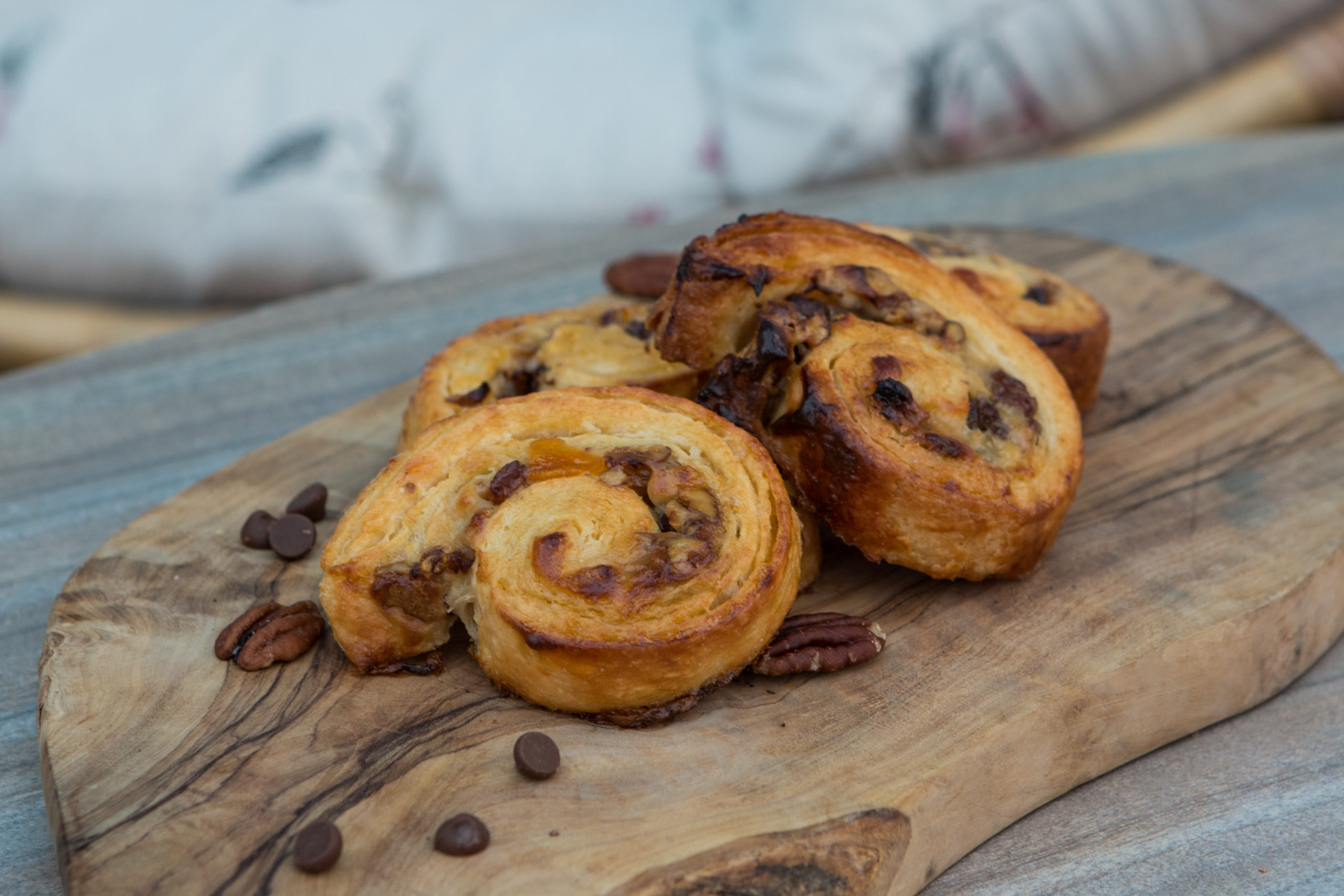Escargots aux raisins et noix
Snails with grapes and nuts anyone? How about some walnut pains aux raisins instead then? They sound a little more appetising. A traditional pain au raisin is a classic French pastry in the form of a spiral, filled with crème patissière and raisins. This recipe also includes walnuts as a twist. I have also seen these pastries referred to as raisin and nut swirls and although they also sound appealing, since the pain au raisin is a household name nowadays it seems a shame to change it.
Viennoiserie
Pains aux raisins belong to the viennoiserie family, which refers to the category of bakes made from yeast-leavened dough or puff pastry which include additional ingredients such as sugar milk or eggs. Examples include croissants, pains au chocolats, brioche, and Danish pastries. Typically eaten for breakfast, these rich buttery delights are happily devoured any time of day.
The word viennoiserie comes from “viennois, -oise”, literally from Vienna, as although these bakes are currently associated with France, their origins can actually be traced back to the Austrian Empire. So how did this Austrian style of baking make it to France in the first place? I’m glad you asked. In the early 19th century a small Austrian-owned bakery which opened in Paris called the Boulangerie Viennoise is thought to be responsible for introducing the first viennoiserie to France. Their bakes took the country by storm and the rest is history. You only have to look at the Kipfel, a traditional Austrian crescent-shaped roll dating back to the 13th century, to see how the French croissant was inspired.
However, that isn’t to say that Austria can be credited with the high standard of pastries we enjoy today, as according to Jim Chevallier’s well-researched book on the topic, August Zang and the French Croissant: How Viennoiserie Came to France, use of puff pastry came later and was a French baking method.
Viennoiseries are essentially enriched doughs (learn more here). The difference between the pastries and brioche however, is that in the pastries the butter sits between the layers of dough and must be kept cold, forming the beautiful flaky layers we all know and love, whereas in brioche the butter is softened and incorporated into the dough itself.

Baking
The recipe used Danish pastry dough, which is similar to croissant dough but in addition to containing sugar, it is further enriched with eggs and milk. This was my first time using fresh yeast and the result did not produce much rise for some reason. However, the pastries were small and nicely formed.
Once the Danish pastry is ready, it is rolled out into a rectangle and covered in crème patissière. The raisins and walnuts were sprinkled on top and pressed in. Next, it was all rolled up into a sausage and after chilling in the freezer for a short amount of time, cut into rounds and left for a final prove. The beauty of these is that you can freeze any excess rounds before the final prove and leave overnight to defrost and prove before baking.
Translation
I came across a few new French words during the translation stage. A “spatule plate”, a flat spatula was required for spreading the crème patissière. I think a palette knife is a more appropriate rendering as it is more often used for spreading than a spatula.
The verb “étaler” was used at several different stages of the recipe, with three different meanings, proving itself to be a versatile culinary term. Depending on the context it meant:
- to roll out (the pastry);
- to press (the butter);
- to spread (the crème patissière).
“Badigeonner” was a new word to me, but you know how it is, once you learn a new word it’s everywhere! It can mean brush or baste and referred to brushing the baked pastries with syrup to give them a shine. In France they tend to use a sugar syrup for glazing, but I opted for my usual apricot jam warmed with a little water, as is often seen in English recipes.
I have come across “faire tiédir” in a number of recipes and interestingly, it can mean to heat up or cool down depending on the context. For this recipe the milk needed heating to make the crème patissière. If the milk had already been heated “faire tiédir” would mean to let it cool to room temperature. Similarly the adjective “tiède” can mean a moderate temperature, neither hot nor cold, i.e. lukewarm or tepid. In a non-culinary context it can mean half-hearted or refer to a lack of enthusiasm.
Conclusion
My viennoiserie skills are far from perfected so I will definitely need to revisit these pastries at some point. I’d highly recommend following Christophe Felder’s example of jazzing up a classic, particularly for pains aux raisins, where so many ingredients would marry well with the traditional raisin filling. Orange zest, pecans, chocolate chips, different flavoured crème patissière, the options are endless. Go wild.
Next time I’m digging into some good old Spanish comfort food.



